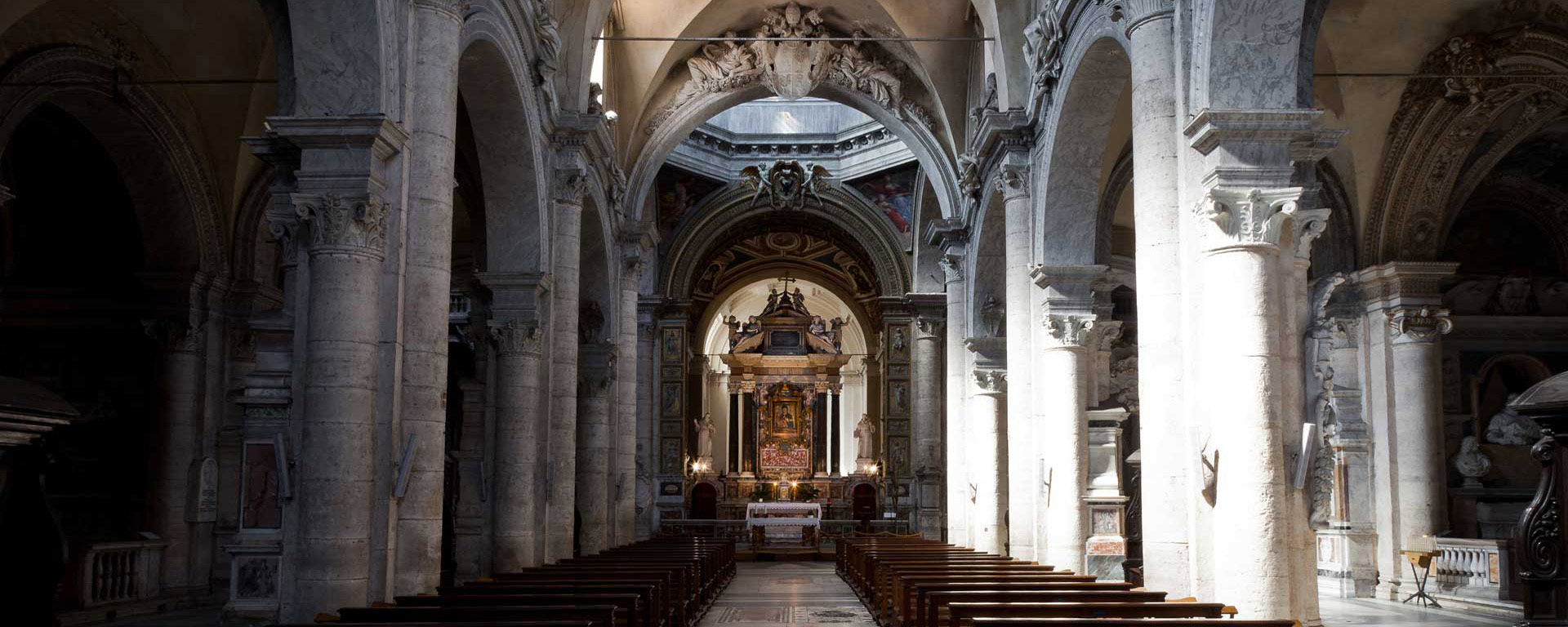
Santa Maria del Popolo
The Basilica of Santa Maria del Popolo or Saint Mary of the People is an Augustinian Church in Piazza del Popolo.
The current building dates from the fifteenth century but originally there had been a smaller chapel here going back to 1099.
santa maria catholic church
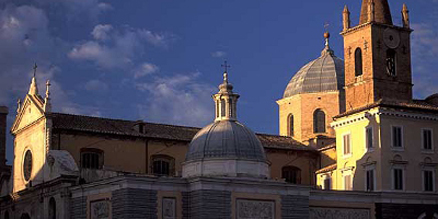 This area used to belong to the Domitia Family, an ancient Roman family from whom the Emperor Nero, real name Lucius Domitius Ahenobarbus, descended.
This area used to belong to the Domitia Family, an ancient Roman family from whom the Emperor Nero, real name Lucius Domitius Ahenobarbus, descended.
He was buried here in his family plot and a dark tree grew out of it, which disturbed the people who lived in the area.
At public request, Pope Paschal II came out here and dedicated the chapel to Mary, the mother of Jesus and to the people of Rome, since they paid for it, which was very unusual.
This chapel was updated to a normal church, where mass services could be given, by Pope Gregory IX (1227 -1241). He gave it to the Augustinians to run, which they still do today.
santa maria church
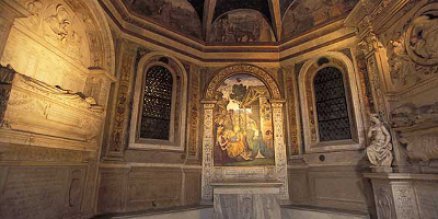 The modern church was constructed by Baccio Pontelli and Andrea Bregno in 1472-1477.
The modern church was constructed by Baccio Pontelli and Andrea Bregno in 1472-1477.
Pope Sixtus IV liked Pontelli’s work so much he asked him to build the Sistine Chapel (1475 -1481).
Between 1655-60 the facade or front was given a facelift by GianLorenzo Bernini, who was asked by Pope Alexander VII to update the Renaissance church to a more modern Baroque style.
Pope Alexander wanted the church to look more impressive for Queen Christina of Sweden who would arrive through the adjacent Porta del Popolo (also by Bernini).
st maria
Altar and Apse
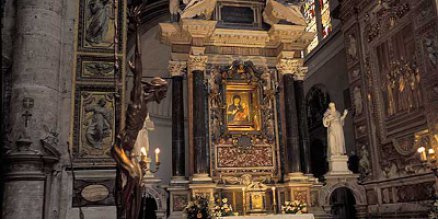 The apse over the altar of Santa Maria del Popolo was designed by Donato Bramante, who was also the first architect of St. Peter’s Basilica.
The apse over the altar of Santa Maria del Popolo was designed by Donato Bramante, who was also the first architect of St. Peter’s Basilica.
He was commissioned by Pope Julius II, who was also from the Della Rovere family of Sixtus IV.
The painted frescoes of the vault are by Pinturicchio and include the Coronation of the Virgin as well as depictions of the Evangelists and Doctors of the Church.
In the 1600s the gilded stucco reliefs were added. If you look closely you can see a large tree with a skeleton beneath it; this shows the original impetus for the building of the church.
chigi chapel
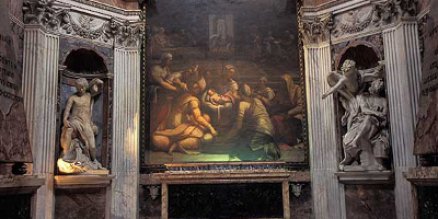 The second chapel on the left is the Chigi Chapel, which was commissioned by Agostino Chigi, the red-haired Papal Banker of the 1500s.
The second chapel on the left is the Chigi Chapel, which was commissioned by Agostino Chigi, the red-haired Papal Banker of the 1500s.
This is his tomb and he paid Raphael to design it. Agostino was one of the richest men in Italy at the time and indeed Western Europe but he was very sensible with money.
He bought a house in Rome right beside the Tiber river. He once gave a dinner party to the Pope and all the important nobles of Rome.
They dined on expensive porcelain plates and when they were finished, Chigi told his servants to throw the plates in the Tiber to save them from washing up.
His guests thought he was really rich to be able to throw away porcelain plates, however they didn’t know that he had nets sitting just under the water in the river so he could get his plates back once all the guests had left.
His monument is on the right hand side, the pyramid on contains his picture. He is buried beneath this. His brother Sigismond is opposite and they are both looking at the altar.
churches in rome italy
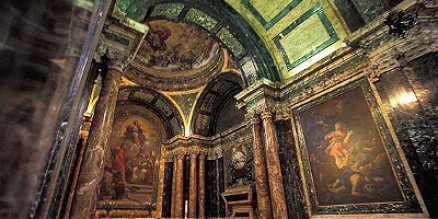 Raphael Sanzio, simply known as Raphael, designed and painted the majority of this chapel in 1516, upon Agostino’s death.
Raphael Sanzio, simply known as Raphael, designed and painted the majority of this chapel in 1516, upon Agostino’s death.
The dome, represents the Creation of the World surrounded by the sun and the seven classical planets, each moved by an angel; it is a rare example of mosaic executed to a High Renaissance design.
People in the middle ages had not spotted Neptune or Pluto by then; so for them there were only 7 planets (Pluto has been downgraded recently).
In the circular paintings here over the archway are four Sibyls or pagan prophetesses.
The altarpiece of the chapel is a Birth of the Virgin by Sebastiano del Piombo, with a bronze bas-relief panel on the altar front of Jesus and the Samaritan Woman, by Lorenzetto.
These are two lesser known Italian painters. On the left, the statues of Jonah and Elijah were carved by Lorenzetto as well, to designs provided by Raphael, who died in 1520 before he finished the chapel.
Jonah of course is the Old Testament prophet who was swallowed by a whale and spat back out three days later.
Elijah is likewise a Jewish Old testament prophet who raised the dead, brought fire down from the sky, and ascended into heaven on a whirlwind.
He is one of the Major Prophets and appears in all three holy books, Torah, Bible and Koran.
On the bottom of the floor is a painting by Raphael. This is the Angel of Death. You can see him holding the hour glass.
The inscription in Latin says Mors ad Caelos. Mors was the god of death and Caelos was the god of the sky or heaven; in Christian terms the Angel of Death.
This is the cover stone to the crypt or tomb where the bodies of these men, and others, are buried beneath us.
rome excursions
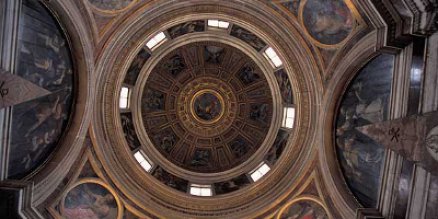 The other two statues on the right hand side of the Chigi Chapel are by GianLorenzo Bernini.
The other two statues on the right hand side of the Chigi Chapel are by GianLorenzo Bernini.
In 1655 Fabio Chigi, of this family, became Pope Alexander VII. He had Bernini make the gate outside for Queen Christina, change the front of the church and design these two statues for his relations’ tomb.
The statue in the bottom right corner is of Habakkuk and the Angel. Habakkuk was an Old Testament minor prophet.
One day he was having lunch and an Angel appeared. The Angel ordered him to share his lunch with Daniel and Habakkuk said, ‘who is Daniel? I don’t know any Daniel!’ So the Angel said, okay I will take you to him, picked him up by the hair and brought him to Daniel. That’s what you are seeing here; you can see the lunch basket on the right.
The other statue is of Daniel, the recipient of said lunch. Daniel was a Jew who worked for the Babylonians as an advisor to the king.
Some native Babylonian advisers became jealous and had the king throw Daniel in to a lion’s den to see if Daniel’s God would save him.
God, of course, sent Habakkuk to help Daniel. Daniel fed the lion Habakkuk’s lunch so the lion would not eat him. The next day he was let out.
The First Altar of Science?
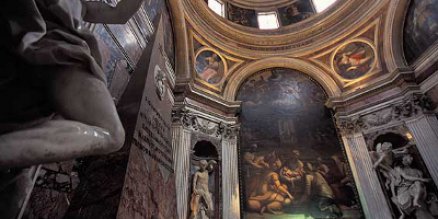 If you are familiar with Dan Brown’s Angels & Demons book and film, this is the first Altar of Science: Earth.
If you are familiar with Dan Brown’s Angels & Demons book and film, this is the first Altar of Science: Earth.
Robert Langdon, played by Tom Hanks in the movie, finds a dead cardinal who was a top pick in that night’s Papal election, down underneath here.
The cardinal has been suffocated to death by having soil shoved down his mouth. He is branded with the ambigram EARTH.
The Angel from Habakkuk points to the next Altar of Science, which is located in St. Peter’s Square which is the second altar of science.
However in the movie they used the police station across the road as the Catholic Church refused permission for Dan Brown’s work to use Catholic locations.
The City of Rome obliged and allowed one of their police stations opposite to be used instead.
caravaggio church rome
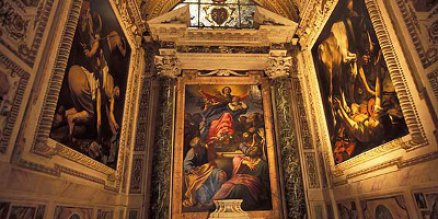 The Cerasi Chapel, at the top left of the church, has two paintings by Caravaggio.
The Cerasi Chapel, at the top left of the church, has two paintings by Caravaggio.
Caravaggio was a 16th century baroque painter, whose real name was Michelangelo Merisi.
He was nicknamed Caravaggio after the town he was from to stop confusion with the original Michelangelo Buonarroti.
He was a talented but dark character and his painting matched his personality.
On the left hand side is the Crucifixion of St. Peter, painted in 1600.
It depicts St. Peter, real name Simon ben Jonah, being crucified on Vatican Hill, here in Rome.
St. Peter was killed by the Emperor Nero in 67 AD during the persecution of Christians.
As you can see in the painting he is upside down. This is because he didn’t want to be crucified in the same way as Jesus as he did not believe he was worthy of such an honour.
Also Roman soldiers liked to crucify their victims in different ways.
Opposite is the Conversion on the Way to Damascus.
This depicts St. Paul, real name Saul of Tarsus, who was originally an agent of Sanhedrin who vilified Christians.
According to Acts of the Apostles, whilst travelling to Damascus in Syria he saw a vision of Jesus saying ‘Saul why do you persecute me?’
He was so struck by this, he fell off his horse. You can see he has his hands up in the air proclaiming what he has seen.
From then on he decided to promote Christianity instead of trying to suppress it.
He is one of the most important figures in the early church and his writings form a key part of the New Testament.
caravaggio conversion of st paul
Annibale Carracci
In the middle of the chapel is the Assumption of the Virgin by Annibale Carracci.
Carracci lived at the same time as Caravaggio and this painting was done in 1601.
It depicts the scene from the bible when the Apostles check the tomb of Mary, Jesus’ mother.
The tomb was empty, and she could not possibly have lifted it. The Catholic Church believes that she was risen or assumed to heaven and left no earthly remains.
Here in the picture, cherubs or baby angels, physically lift her up while the Apostles recoil, having checked the tomb as being empty, realizing what happened.
Santa Maria del Popolo is a great place to start a walking tour of Rome, as it has its own Metro Stop Flaminio and is in walking distance of the Spanish Steps and many other of the squares of Rome.
If you would like to book a walking tour of the city of Rome including Santa del Popolo you can do so in the side menu.
3 hour Walking Tour of the Piazzas and Fountains of Rome Italy
Rated 5.0/5 based on a selection 10 customer reviews out of thousands.
